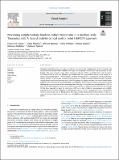Processing complementary foods to reduce mycotoxins in a medium scale Tanzanian mill: A hazard analysis critical control point (HACCP) approach

View/
Date
2024-03-22Author
Ngure, Francis
Makule, Edna
Mgongo, William
Phillips, Erica
Kassim, Neema
Stoltzfus, Rebecca
Nelson, Rebecca
Metadata
Show full item recordAbstract
Designing and implementing processing procedures for producing safe complementary foods in dynamic and
unregulated food systems where common food staples are frequently contaminated with mycotoxins is chal-
lenging. This paper presents lessons about minimizing aflatoxins (AF) in groundnut flour and AF and/or
fumonisins (FUM) in maize and groundnut pre-blended flour for complementary feeding in the context of a
dietary research intervention in rural Tanzania. The flours were processed in collaboration with Halisi Products
Limited (Halisi), a medium scale enterprise with experience in milling cereal-based flours in Arusha, Tanzania.
Using a hazard analysis critical control point (HACCP) approach for quality assurance, two critical control points
(CCPs) for AF in processing the pre-blended flour were identified: 1) screening maize before procurement, and 2)
blending during the processing of each constituent flour. Blending of maize flour was also identified as a CCP for
FUM. Visual inspection during screening and sorting were identified as important control measures for reducing
AF, but these steps did not meet the criteria for a CCP due to lack of objective measurement and verifiable
standards for AF. The HACCP approach enabled the production of low AF (<5 μg/kg) and FUM (<2 μg/g) flours
with low rejection rates for the final products. The paper presents practical lessons that could be of value to a
range of commercial processors in similar low- and middle-income contexts who are keen on improving food
quality.
URI
https://doi.org/10.1016/j.foodcont.2024.110463https://dspace.nm-aist.ac.tz/handle/20.500.12479/2642
